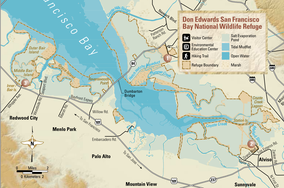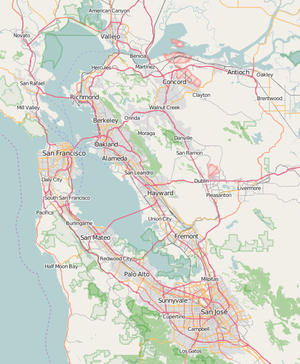Don Edwards San Francisco Bay National Wildlife Refuge
United States National Wildlife Reserve in San Francisco Bay From Wikipedia, the free encyclopedia
Don Edwards San Francisco Bay National Wildlife Refuge (DESFBNWR) is a United States National Wildlife Refuge located in the southern part of San Francisco Bay, California. Its headquarters and visitor center are in the Baylands district of Fremont, next to Coyote Hills Regional Park, in Alameda County. The visitor center is on Marshlands Rd, off Thornton Ave.[2]
| Don Edwards San Francisco Bay National Wildlife Refuge | |
|---|---|
IUCN category IV (habitat/species management area) | |
 Map of the DESFBNWR (2003) | |
| Location | Alameda County, San Mateo County, Santa Clara County, California, United States |
| Nearest city | Newark, California |
| Coordinates | 37°30′00″N 122°07′00″W[1] |
| Area | 30,000 acres (120 km2) |
| Established | 1974 |
| Governing body | U.S. Fish and Wildlife Service |
| Website | www |
Most of the refuge stretches along the marshy shoreline north and south of the Dumbarton Bridge, but Bair Island, in San Mateo County, is also part of the system. The southernmost extent is in northern Santa Clara County.
History
It was founded in 1974 as the first urban National Wildlife Refuge established in the United States, and it is dedicated to preserving and enhancing wildlife habitat, protecting migratory birds, protecting threatened and endangered species, and providing opportunities for wildlife-oriented recreation and nature study for the surrounding communities.
As of 2004, the refuge spanned 30,000 acres (120 km2) of open bay, salt pond, salt marsh, mudflat, upland and vernal pool habitats located throughout south San Francisco Bay. About 9,000 acres (36 km2) of salt ponds within the refuge are managed by Cargill Salt, which has perpetual salt-making rights. Cargill uses the salt ponds to concentrate brines as part of its solar salt operation which produces salt for food, agriculture, medical, and industrial uses throughout the Western United States.[3]
Located along the Pacific Flyway, the refuge hosts over 280 species of birds each year. The variety of birds that may call the refuge home or use it as a stopover include white pelicans, white-tailed kites, hawks, ospreys, and eagles. Millions of shorebirds and waterfowl stop to refuel here during the spring and fall migration. It also provides critical habitat to resident species like the endangered California clapper rail and salt marsh harvest mouse. Hundreds of thousands of people visit its diverse wildlife and habitats each year.
The DESFBNWR is one of six wildlife refuges in the San Francisco Bay Area. The others are: Antioch Dunes, Ellicott Slough, Farallon, Marin Islands, and San Pablo Bay. It was renamed in 1995 in recognition of Congressman Don Edwards and his efforts to protect sensitive wetlands in south San Francisco Bay.
Gallery
|
See also
References
External links
Wikiwand in your browser!
Seamless Wikipedia browsing. On steroids.
Every time you click a link to Wikipedia, Wiktionary or Wikiquote in your browser's search results, it will show the modern Wikiwand interface.
Wikiwand extension is a five stars, simple, with minimum permission required to keep your browsing private, safe and transparent.











